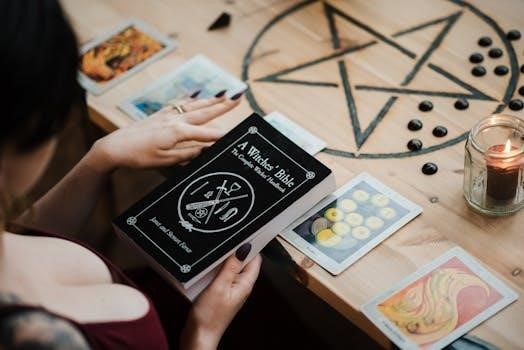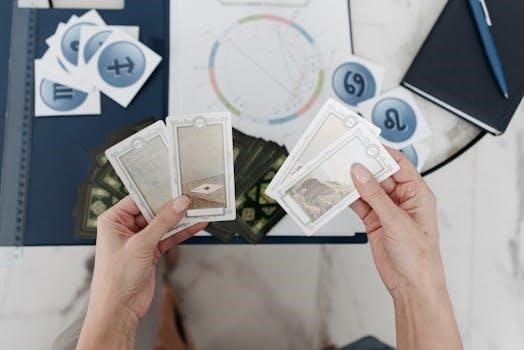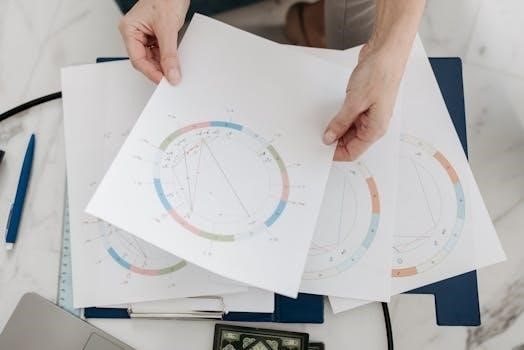The tarot, a soul map comprised of 78 symbolic cards, originated in 15th-century Italy as a game called Tarocchi. It wasn’t initially for interpretation. Scholarly research indicates its use among the wealthy, evolving into a tool for insight.
What is Tarot and Its Origins
The tarot is essentially a soul map, a profound psychological guide to self-empowerment. It’s visualized through 78 symbolic cards. Long surpassing the fortune teller stereotype, scholarly research suggests the cards originated in Italy in the 1500s. They were initially a game called Tarocchi, enjoyed by the very wealthy. Tarot wasn’t originally used for interpretive purposes.
The cards offer a deep dive into self-understanding and inner growth. Learning to use tarot involves blending intuition with familiarity. It provides introspection and guidance. It is a comprehensive guide to accessing inner wisdom.
Understanding the Structure of a Tarot Deck
The deck consists of the Major and Minor Arcana. Together, they create a comprehensive pictorial language. All the answers we seek exist within the deck. Each card illustrates a person, circumstance, or potential outcome.
Major Arcana⁚ Archetypes and Life Lessons
The Major Arcana cards reveal messages about the big picture of your life and its long-term direction. Each card symbolizes a potential strength, which will be unfolded through the other Arcana. The Major Arcana cards are about action, initiative, and invention. They help guide how you move through your life, advising when to move and when to hold back. Tarot does not require any spiritual background, acknowledgement of the occult or psychic forces in order to be able to enjoy and/or benefit from it.
Minor Arcana⁚ Suits and Everyday Matters
These suits reveal which spheres offering guidance on how to best manage any circumstances at hand. The Wands cards are about action, initiative, and invention. They help to guide how you move through your life, advising when to move and when to hold back. Learning how to use tarot requires a strong mix of intuition and familiarity with the symbols of the tarot. The Minor Arcana cards create a comprehensive pictorial language. It is important to remember that all the answers we seek exist innately within the deck.
Basic Principles of Tarot Card Interpretation
Trust your intuition and go with the meanings that feel right for you. Learning how to use tarot requires a strong mix of intuition and familiarity with the symbols of the tarot. The ability to discern meaning lies within your narrative interpretation.
The Importance of Intuition
Tarot does not require any spiritual background. It is a means to connect with your intuition, based on the belief that cards come out randomly. There are no right or wrong meanings, trust your feelings. Sure, there are traditional interpretations, but I encourage you to go with the meanings that resonate. Let the tarot card meanings be your guide, not your gospel. Intuition and familiarity are the keys to learning how to use tarot.
Upright and Reversed Card Meanings
The beauty of Tarot is that it resonates with experienced Tarot readers alike. Each card has detailed sections on upright and reversed interpretations. It gives insight into how the card’s meaning shifts depending on its orientation. Reversed meanings introduce another layer, sometimes signifying the opposite of the upright meaning. They can also indicate blockages, delays, or internal conflicts related to the card’s theme. Quick reference guides include keywords.
Key Elements in a Tarot Reading
Each card gains nuance when paired with others. Tarot card readings are like short stories. The artistry lies in creating a coherent reading. This is a big challenge. Card combinations reveal deeper insights.
Card Combinations and Their Significance
Each tarot card gains new meaning when seen alongside others in a reading. The interplay between cards can reveal deeper layers of insight and nuance, highlighting connections and potential outcomes that a single card might not fully convey. Understanding these combinations requires careful observation and intuition, as certain pairings can amplify or modify the individual card meanings. By analyzing the relationships between cards, readers can construct a more comprehensive and accurate interpretation, leading to a richer and more meaningful reading experience, creating a cohesive narrative from the spread.
Creating a Coherent Reading from a Spread
Creating a coherent reading from a tarot spread is a significant challenge, demanding artistry and intuitive magic. It involves weaving together the individual card meanings into a cohesive narrative that addresses the querent’s questions or concerns. Begin by identifying the central themes and patterns that emerge from the spread, considering the positions of the cards and their relationships to one another. Look for repeating suits or numbers, as these can indicate areas of emphasis or potential obstacles. The ability to discern meaning lies within your own narrative interpretation.

Resources for Learning Tarot Card Interpretation
For beginners, many books and guides can help. “The Complete Book of Tarot” is instructive and inspiring. Such guides provide detailed sections on upright and reversed interpretations. A quick reference guide including keywords, is helpful too.
Books and Guides for Beginners
If you want to interpret the cards for deeper self-understanding, you will find “The Complete Book of Tarot” both instructive and inspiring. The Amazon Book Review is also a good resource. “Tarot for Change” is another popular book. For each card, find detailed sections on upright and reversed interpretations.
A quick reference guide, including keywords, is included. “The Ultimate Guide to Tarot Card Meanings” offers upright and reversed Tarot card meanings. Explore interpretations for everyday situations, journaling prompts, and keyword charts. Some books also provide digital PDF guides.
Online Courses and Communities
For advancing your tarot interpretation skills, Francisco has a podcast. Jessica Dore, author of “Tarot for Change,” periodically offers online courses. Little Red Tarot also offers an eight-week course on a sliding scale, providing a wealth of resources from free guides to certification. Biddy Tarot provides a wealth of resources, from free guides to certification.
These platforms offer structured learning and community support, enhancing your understanding and providing a space to connect with other learners. Such environments can be very helpful for developing your own tarot reading skills.
Digital guides offer quick references for tarot card interpretations. These free PDF resources provide key concepts and strategies. They are beneficial for both beginners and experienced readers seeking readily available information.
Free PDF Resources for Tarot Card Meanings
Digital Guides for Quick Reference
For those seeking immediate guidance, numerous free digital PDF guides provide quick references for tarot card meanings. These resources often include key concepts for each card, offering a concise overview for on-the-spot interpretations. Many guides also incorporate general strategies for reading spreads, aiding in the creation of coherent narratives. These digital aids are particularly useful for beginners or readers needing a handy reference tool. They can significantly enhance the speed and accuracy of your interpretations. Always remember to use these guides as a foundation and trust your own intuition for a personal reading.
Interpreting Tarot Card Meanings in Specific Contexts
Tarot card meanings adapt to specific contexts like relationships, career, finances, and well-being. Interpretations shift, providing tailored insights into these areas of life. Understanding these nuances enhances the reading’s relevance and accuracy.
Relationships, Career, Finances, and Well-being
The Ultimate Guide to Tarot Card Meanings offers interpretations for everyday situations, spanning relationships, career, finances, and well-being. Inside, you will find journaling prompts and keyword charts. Exploring tarot provides insights to understand challenges, make informed decisions, and gain clarity. The tarot provides guidance, encouraging introspection. Each card takes on new meaning with other cards. Tarot offers a framework for reflection, helping you to navigate these key areas. These readings can help guide your journey and help you to get new perspectives.
Tarot Card Meanings⁚ Major Arcana
The Major Arcana cards reveal messages about the big picture of your life and its long-term direction. They represent significant life lessons, archetypes, and pivotal moments. This is a free digital PDF card interpretation guide for key concepts. In the detailed Major Arcana card descriptions, you will read symbolism. They guide towards answers you seek, evolving from years of study. There are no correct or right interpretations, but these foundations should guide you. The first card symbolizes a potential strength.

Tarot Card Meanings⁚ Minor Arcana
The Minor Arcana suits reveal which spheres of your life the cards are dealing with, offering guidance on how to best manage circumstances at hand. The Wands cards are about action, initiative, and invention, guiding how you move through life. They advise when to move and when to hold back. This is a free digital PDF card interpretation guide for key concepts. These foundations should guide you towards the answers you seek, evolving from years of study.

Tips for Developing Your Tarot Reading Skills
Taking notes and journaling can enhance your interpretation skills. As a professional tarot reader, I find that taking notes is invaluable. Record your readings, interpretations, and insights to track your progress.
Taking Notes and Journaling
As you delve into tarot, meticulous note-taking and journaling become indispensable tools. Each card’s meaning evolves with experience, so document your readings diligently. Record the date, the question asked, the cards drawn, and your initial interpretation. Later, revisit these entries to compare your insights with the actual outcomes, noting patterns and nuances. Journaling illuminates your personal connection to the cards, refining your intuition and solidifying your understanding. This practice transforms tarot from a set of memorized meanings to a dynamic, personalized language, enhancing your accuracy and confidence in future readings.
Trusting Your Intuition
Intuition is paramount in tarot reading. While traditional meanings offer a foundation, your inner voice provides unique insights. Embrace feelings and impressions that arise during a reading, allowing them to color your interpretation; Remember, there are no “wrong” meanings; trust what resonates with you. This trust develops with practice, strengthening your connection to the cards. Intuition enables you to move beyond rote memorization, creating a dynamic and personalized reading experience. As your confidence grows, so will the depth and accuracy of your readings, transforming tarot into a powerful tool for self-discovery and guidance.

Embracing Tarot as a Tool for Self-Discovery
Tarot offers a profound pathway to self-understanding and empowerment, acting as a mirror reflecting inner landscapes. By exploring the archetypes and narratives within the cards, individuals can gain clarity on their life’s journey. It’s more than just divination; it’s a tool for introspection and personal growth. Embrace intuition and trust the messages that resonate, allowing the tarot to guide you toward greater self-awareness. Whether faith-driven or secular, the cards provide a framework for navigating life’s complexities. The magic of tarot lies in its ability to unlock inner wisdom and foster a deeper connection with oneself.